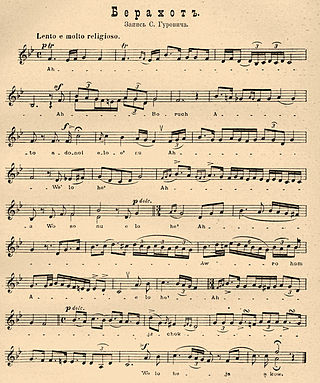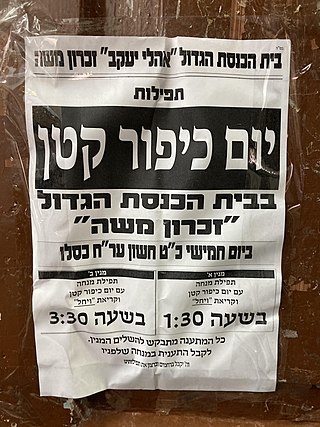Related Research Articles

Jewish holidays, also known as Jewish festivals or Yamim Tovim, are holidays observed by Jews throughout the Hebrew calendar. They include religious, cultural and national elements, derived from three sources: mitzvot, rabbinic mandates, the history of Judaism, and the State of Israel.

Sukkot, also known as the Feast of Tabernacles or Feast of Booths, is a Torah-commanded holiday celebrated for seven days, beginning on the 15th day of the month of Tishrei. It is one of the Three Pilgrimage Festivals on which Israelites were commanded to make a pilgrimage to the Temple in Jerusalem. Biblically an autumn harvest festival and a commemoration of the Exodus from Egypt, Sukkot’s modern observance is characterized by festive meals in a sukkah, a temporary wood-covered hut.
Shemini Atzeret is a Jewish holiday. It is celebrated on the 22nd day of the Hebrew month of Tishrei, usually coinciding with late September or early October. It directly follows the festival of Sukkot, which is celebrated for seven days; thus, Shemini Atzeret is literally the eighth day [of assembly]. It is a separate—yet connected—holy day devoted to the spiritual aspects of the festival of Sukkot. Part of its duality as a holy day is that it is simultaneously considered to be connected to Sukkot and a separate festival in its own right.

The Amidah, also called the Shemoneh Esreh, is the central prayer of the Jewish liturgy. Observant Jews recite the Amidah at each of three daily prayer services in a typical weekday: morning (Shacharit), afternoon (Mincha), and evening (Ma'ariv). On Shabbat, Rosh Chodesh, and Jewish festivals, a fourth Amidah (Mussaf) is recited after the morning Torah reading, and once per year, a fifth Amidah (Ne'ilah) is recited, around sunset, on Yom Kippur. Due to the importance of the Amidah, in rabbinic literature, it is simply called "hatefila". According to legend, the prayer was composed by the rabbis of the Anshei Knesset HaGedolah. Accordingly, in Judaism, to recite the Amidah is a mitzvah de-rabbanan, i. e., a commandment of rabbinic origin.
Moed is the second Order of the Mishnah, the first written recording of the Oral Torah of the Jewish people. Of the six orders of the Mishna, Moed is the third shortest. The order of Moed consists of 12 tractates:
- Shabbat: or Shabbath ("Sabbath") deals with the 39 prohibitions of "work" on the Shabbat. 24 chapters.
- Eruvin: (ערובין) ("Mixtures") deals with the Eruv or Sabbath-bound - a category of constructions/delineations that alter the domains of the Sabbath for carrying and travel. 10 chapters.
- Pesahim: (פסחים) deals with the prescriptions regarding the Passover and the paschal sacrifice. 10 chapters.
- Shekalim: (שקלים) ("Shekels") deals with the collection of the half-Shekel as well as the expenses and expenditure of the Temple. 8 chapters
- Yoma: (יומא) ; called also "Kippurim" or "Yom ha-Kippurim" ; deals with the prescriptions Yom Kippur, especially the ceremony by the Kohen Gadol. 8 chapters.
- Sukkah: (סוכה) ("Booth"); deals with the festival of Sukkot and the Sukkah itself. Also deals with the Four Species which are waved on Sukkot. 5 chapters.
- Beitza: (ביצה) ("Egg"); deals chiefly with the rules to be observed on Yom Tov. 5 chapters.
- Rosh Hashanah: deals chiefly with the regulation of the calendar by the new moon, and with the services of the festival of Rosh Hashanah. 4 chapters.
- Ta'anit: (תענית) ("Fasting") deals chiefly with the special fast-days in times of drought or other untoward occurrences. 4 chapters
- Megillah: (מגילה) ("Scroll") contains chiefly regulations and prescriptions regarding the reading of the scroll of Esther at Purim, and the reading of other passages from the Torah and Neviim in the synagogue. 4 chapters.
- Mo'ed Katan: deals with Chol HaMoed, the intermediate festival days of Pesach and Sukkot. 3 chapters.
- Hagigah: (חגיגה) deals with the Three Pilgrimage Festivals and the pilgrimage offering that men were supposed to bring in Jerusalem. 3 chapters.

Hoshana Rabbah is the seventh day of the Jewish holiday of Sukkot, the 21st day of the month of Tishrei. This day is marked by a special synagogue service, the Hoshana Rabbah, in which seven circuits are made by the worshippers with their lulav and etrog, while the congregation recites Hoshanot. It is customary for the scrolls of the Torah to be removed from the ark during this procession. In a few communities a shofar is sounded after each circuit.
Hallel is a Jewish prayer, a verbatim recitation from Psalms 113–118 which is recited by observant Jews on Jewish holidays as an act of praise and thanksgiving.
Mussaf is an additional service that is recited on Shabbat, Yom Tov, Chol Hamoed, and Rosh Chodesh. The service, which is traditionally combined with the Shacharit in synagogues, is considered to be additional to the regular services of Shacharit, Mincha, and Maariv. In contemporary Hebrew, the word may also signify a newspaper supplement.
Isru Chag refers to the day after each of the Three Pilgrimage Festivals in Judaism: Passover, Shavuot and Sukkot.
Special Shabbatot are Jewish Shabbat days on which special events are commemorated. Variations in the liturgy and special customs differentiate them from the other Shabbats and each one is referred to by a special name. Many communities also add piyyutim on many of these special Shabbatot. Two such Shabbats, Shabbat Mevarchim—the Shabbat preceding a new Hebrew month—and Shabbat Rosh Chodesh can occur on several occasions throughout the year. The other special Shabbats occur on specific sabbaths before or coinciding with certain Jewish holidays during the year according to a fixed pattern.
Pesukei dezimra, or zemirot as they are called in the Spanish and Portuguese tradition, are a group of prayers that may be recited during Shacharit. They consist of various blessings, psalms, and sequences of other Biblical verses. Historically, reciting pesukei dezimra in morning prayer was a practice of only the especially pious. Over the course of Jewish history, their recitation has become widespread custom among all of the various rites of Jewish prayer.
The modern Hebrew calendar has been designed to ensure that certain holy days and festivals do not fall on certain days of the week. As a result, there are only four possible patterns of days on which festivals can fall.
On Yom Tov the Torah is read during Shacharit services.
Nusach Ashkenaz is a style of Jewish liturgy conducted by Ashkenazi Jews. It is primarily a way to order and include prayers, and differs from Nusach Sefard and Baladi-rite prayer, and still more from the Sephardic rite proper, in the placement and presence of certain prayers.

Yom Kippur Katan, is a practice observed by some Jews on the day preceding each Rosh Chodesh. The observance consists of fasting and supplication, but is much less rigorous than that of Yom Kippur proper.

Maariv or Maʿariv, also known as Arvit, or Arbit, is a Jewish prayer service held in the evening or night. It consists primarily of the evening Shema and Amidah.
Yom tov sheni shel galuyot, also called in short yom tov sheni, means "the second festival day in the Diaspora". This is a principle in halakha that mandates the observance of an additional day for Jewish holidays outside the Land of Israel.

Pesach Sheni occurs every year on 14 Iyar. This is exactly one month after 14 Nisan, the day before Passover, which was the day prescribed for bringing the Korban Pesach in anticipation of that holiday. As described in the source text for this mitzvah, the Israelites were about to celebrate Passover one year after leaving Egypt.
A hakafah is a Jewish minhag (tradition) in which people walk or dance around a specific object, generally in a religious setting.
References
- 1 2 3 "Ĥol Ha-mo'ed Defined - Jewish Tradition". yahadut.org. Retrieved 2024-03-31.
- 1 2 "01. Ḥol Ha-mo'ed – Peninei Halakha" . Retrieved 2024-03-31.
- ↑ Shulchan Aruch , Orach Chayim , 530
- ↑ "Chol HaMoed - Intermediary Days". www.jewishvirtuallibrary.org. Retrieved 2024-03-31.
- ↑ "11 -Ya'aleh VeYavo in Grace After Meals – Peninei Halakha" . Retrieved 2024-03-31.
- 1 2 See Shorshei Minhag Ashkenaz volume 5. This 900-page work contains everything there is to know about tefillin on Chol Hamoed.
- ↑ This name is used universally, and is to be construed as "the Sabbath of Chol HaMoed." Although the name includes the word Chol (weekday), the day is the Sabbath in every respect, not a (halachic) weekday.
